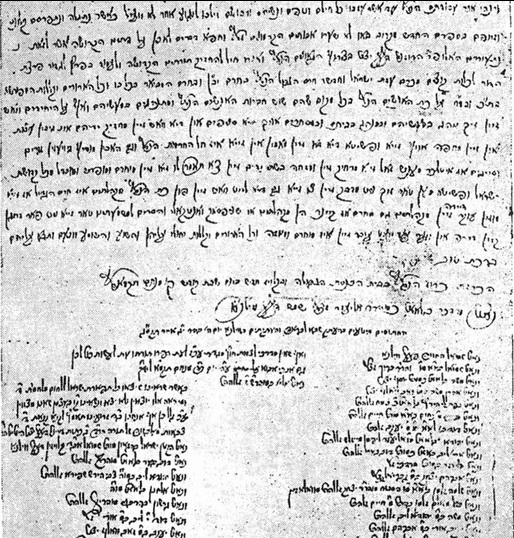|
Bnei Yoel
The Bnei Yoel (Sons of Joel) are a group of Satmar Hasidim, who, after the death of Joel Teitelbaum, refused to accept the leadership of the new Grand Rabbi of Satmar, Rebbe Moshe Teitelbaum, and instead decided to remain followers of Rabbi Joel. They are also known as: *"The Rebbetzin's Hasidim", referring to Joel Teitelbaum's surviving wife, Alte Feiga Teitelbaum (1912-2001). (A "rebbetzin" is the title for an Orthodox rabbi's wife.) *"''keygeners''", meaning those "who go against" something (in Yiddish.) *"''misnagdim''," "opponents" in Yiddish, but not to be confused with the non-Hasidic movement of the misnagdim, the ideological opponents of the original Hasidic movement in the 18th century. Some members of the Bnei Yoel have taken the side of Rabbi Zalman Leib Teitelbaum in the dispute that erupted about the succession of Moshe Teitelbaum, in which brothers Aaron Teitelbaum Aaron Teitelbaum (born 20 October 1947) is one of the two Grand ''Rebbe''s of Satmar, and th ... [...More Info...] [...Related Items...] OR: [Wikipedia] [Google] [Baidu] |
Satmar (Hasidic Dynasty)
Satmar (Yiddish: סאַטמאַר, Hebrew: סאטמר) is a Hasidic group founded in 1905 by Grand Rebbe Joel Teitelbaum, in the city of Szatmárnémeti, Hungary (now Satu Mare in Romania). The group is an offshoot of the Sighet Hasidic dynasty. Following World War II, it was re-established in New York. Satmar is the largest Hasidic dynasty in the world, with some 26,000 households. It is characterized by extreme conservatism, complete rejection of modern culture, and fierce anti-Zionism. Satmar sponsors a comprehensive education and media system in Yiddish, and its members use Yiddish as a primary language. The sect also sponsors and leads the Central Rabbinical Congress, which serves as an umbrella organization for other very conservative, anti-Zionist, and mostly Hungarian-descended ultra-Orthodox communities. After Joel Teitelbaum's death in 1979, he was succeeded by his nephew, Moshe Teitelbaum. Since the latter's death in 2006, the dynasty is split between his two sons, ... [...More Info...] [...Related Items...] OR: [Wikipedia] [Google] [Baidu] |
Hasidic Judaism
Hasidism, sometimes spelled Chassidism, and also known as Hasidic Judaism (Ashkenazi Hebrew: חסידות ''Ḥăsīdus'', ; originally, "piety"), is a Judaism, Jewish religious group that arose as a spiritual revival movement in the territory of contemporary Western Ukraine during the 18th century, and spread rapidly throughout Eastern Europe. Today, most affiliates reside in Israel and the United States. Israel Ben Eliezer, the "Baal Shem Tov", is regarded as its founding father, and his disciples developed and disseminated it. Present-day Hasidism is a sub-group within Haredi Judaism and is noted for its religious conservatism and social seclusion. Its members adhere closely both to Orthodox Judaism, Orthodox Jewish practice – with the movement's own unique emphases – and the traditions of Eastern European Jews. Many of the latter, including various special styles of dress and the use of the Yiddish language, are nowadays associated almost exclusively with Hasidism. Hasi ... [...More Info...] [...Related Items...] OR: [Wikipedia] [Google] [Baidu] |
Joel Teitelbaum
Joel Teitelbaum ( yi, יואל טייטלבוים, translit=Yoyl Teytlboym, ; 13 January 1887 – 19 August 1979) was the founder and first Grand Rebbe of the Satmar dynasty. A major figure in the post-war renaissance of Hasidism, he espoused a strictly conservative and isolationist line, rejecting modernity. Teitelbaum was a fierce opponent of Zionism, which he decried as inherently heretical. His role as a Jewish community leader in Transylvania during the Holocaust remains controversial. Biography Early life Teitelbaum was born on January 13, 1887. He was the second son of Grand Rabbi of Sighet, Chananyah Yom Tov Lipa Teitelbaum, and his second wife, Chana Ashkenazi. The couple married in 1878, after receiving a special dispensation for him to take a second wife, as his first wife, Reitze – daughter of Rebbe Menashe Rubin of Ropshitz – was unable to bear children. Joel was the youngest child; he had four older siblings. The rabbis of the Teitelbaum family were k ... [...More Info...] [...Related Items...] OR: [Wikipedia] [Google] [Baidu] |
Moshe Teitelbaum (Satmar)
Moshe (Moses) Teitelbaum (Yiddish: משה טײטלבױם; November 1, 1914 – April 24, 2006) was a Hasidic rebbe and the world leader of the Satmar Hasidim. Early life Moshe Teitelbaum was born on November 17, 1914, in Újfehértó, Hungary. He was the second son of Rabbi Chaim Tzvi Teitelbaum, author of ''Atzei Chaim'', the previous Sigheter Rebbe. His mother, Bracha Sima, hailed from the prominent Halbershtam family. Moshe and his older brother, Yekusiel Yehuda Teitelbaum, were orphaned in 1926, when they were eleven and fourteen, respectively. Moshe was raised by family friends and relatives, including his uncle, Joel Teitelbaum, and his grandfather, Rabbi Shulem Eliezer Halberstam of Ratzfert.פתגמין קדישין תכ"ג Teitelbaum received rabbinical Ordination, and was appointed dean of the Karacscka yeshiva. In 1936, Teitelbaum married Leah Meir, daughter of Rabbi Hanoch Heinoch Meir of Karecska. In 1939, he became the rabbi of Senta, Yugoslavia (now Serbi ... [...More Info...] [...Related Items...] OR: [Wikipedia] [Google] [Baidu] |
Faige Teitelbaum
Faige Teitelbaum (April 16, 1912 - June 2, 2001) ( yi, אלטא פייגא טייטלבוים), born Alta Fajge Szapiro and known as the Satmar Rebbetzin, was an American Hasidic community leader. Teitelbaum's status as Rebbetzin was gained through her marriage to the first Rebbe (leader) of the Satmar Hasidic community, Rabbi Joel Teitelbaum (1887-1979). After her husband's death, the Satmar Rebbetzin gained a following of supporters who stood in opposition to her husband's successor, the second Rebbe of Satmar, Rabbi Moshe Teitelbaum (1914-2006). Biography Faige Teitelbaum was born in Częstochowa, Poland, to Rabbi Awigdor Szapiro of the Kosnitz Hasidic dynasty. In 1936, she married Rabbi Joel Teitelbaum after the death of Joel's first wife. Following the death of Rabbi Joel Teitelbaum in 1979 and his succession by Moshe (Moses) Teitelbaum, a nephew of Joel, a segment of the Satmar community rejected the new leadership and remained committed to the deceased Rebbe. This group b ... [...More Info...] [...Related Items...] OR: [Wikipedia] [Google] [Baidu] |
Rebbetzin
Rebbetzin ( yi, רביצין) or Rabbanit ( he, רַבָּנִית) is the title used for the wife of a rabbi—typically among Orthodox, Haredi, and Hasidic Jews—or for a female Torah scholar or teacher. Etymology The Yiddish word has a trilingual etymology: Hebrew, ''rebbə'' ("master"); the Slavic feminine suffix, ''-itsa''; and the Yiddish feminine suffix, ''-in.'' A male or female rabbi may have a male spouse but, as women and openly gay men were prohibited from the rabbinate for most of Jewish history, there has historically been no specific term for the male spouse of a rabbi. In a 2020 piece, Rob Eshman, the national editor of ''The Forward'' and the husband of a female rabbi, wrote: "Nobody knew what to call me" because "there wasn't a word for what I was." Some contemporary male spouses of rabbis have chosen to call themselves "rebbetzers." Community roles In many Orthodox communities, rebbetzins have the role of spiritual counselors. In circles such as the ... [...More Info...] [...Related Items...] OR: [Wikipedia] [Google] [Baidu] |
Orthodox Judaism
Orthodox Judaism is the collective term for the traditionalist and theologically conservative branches of contemporary Judaism. Theologically, it is chiefly defined by regarding the Torah, both Written and Oral, as revealed by God to Moses on Mount Sinai and faithfully transmitted ever since. Orthodox Judaism, therefore, advocates a strict observance of Jewish law, or ''halakha'', which is to be interpreted and determined exclusively according to traditional methods and in adherence to the continuum of received precedent through the ages. It regards the entire ''halakhic'' system as ultimately grounded in immutable revelation, and beyond external influence. Key practices are observing the Sabbath, eating kosher, and Torah study. Key doctrines include a future Messiah who will restore Jewish practice by building the temple in Jerusalem and gathering all the Jews to Israel, belief in a future bodily resurrection of the dead, divine reward and punishment for the righteous and ... [...More Info...] [...Related Items...] OR: [Wikipedia] [Google] [Baidu] |
Rabbi
A rabbi () is a spiritual leader or religious teacher in Judaism. One becomes a rabbi by being ordained by another rabbi – known as '' semikha'' – following a course of study of Jewish history and texts such as the Talmud. The basic form of the rabbi developed in the Pharisaic (167 BCE–73 CE) and Talmudic (70–640 CE) eras, when learned teachers assembled to codify Judaism's written and oral laws. The title "rabbi" was first used in the first century CE. In more recent centuries, the duties of a rabbi became increasingly influenced by the duties of the Protestant Christian minister, hence the title " pulpit rabbis", and in 19th-century Germany and the United States rabbinic activities including sermons, pastoral counseling, and representing the community to the outside, all increased in importance. Within the various Jewish denominations, there are different requirements for rabbinic ordination, and differences in opinion regarding who is recognized as a rabbi. For ex ... [...More Info...] [...Related Items...] OR: [Wikipedia] [Google] [Baidu] |
Yiddish Language
Yiddish (, or , ''yidish'' or ''idish'', , ; , ''Yidish-Taytsh'', ) is a West Germanic language historically spoken by Ashkenazi Jews. It originated during the 9th century in Central Europe, providing the nascent Ashkenazi community with a vernacular based on High German fused with many elements taken from Hebrew (notably Mishnaic) and to some extent Aramaic. Most varieties of Yiddish include elements of Slavic languages and the vocabulary contains traces of Romance languages.Aram Yardumian"A Tale of Two Hypotheses: Genetics and the Ethnogenesis of Ashkenazi Jewry".University of Pennsylvania. 2013. Yiddish is primarily written in the Hebrew alphabet. Prior to World War II, its worldwide peak was 11 million, with the number of speakers in the United States and Canada then totaling 150,000. Eighty-five percent of the approximately six million Jews who were murdered in the Holocaust were Yiddish speakers,Solomon Birnbaum, ''Grammatik der jiddischen Sprache'' (4., erg. Aufl., Hambu ... [...More Info...] [...Related Items...] OR: [Wikipedia] [Google] [Baidu] |
Misnagdim
''Misnagdim'' (, "Opponents"; Sephardi pronunciation: ''Mitnagdim''; singular ''misnaged''/''mitnaged'') was a religious movement among the Jews of Eastern Europe which resisted the rise of Hasidism in the 18th and 19th centuries. The ''Misnagdim'' were particularly concentrated in Lithuania, where Vilnius served as the bastion of the movement, but anti-Hasidic activity was undertaken by the establishment in many locales. The most severe clashes between the factions took place in the latter third of the 18th century; the failure to contain Hasidism led the ''Misnagdim'' to develop distinct religious philosophies and communal institutions, which were not merely a perpetuation of the old status quo but often innovative. The most notable results of these efforts, pioneered by Chaim of Volozhin and continued by his disciples, were the modern, independent ''yeshiva'' and the Musar movement. Since the late 19th century, tensions with the Hasidim largely subsided, and the heirs of ''M ... [...More Info...] [...Related Items...] OR: [Wikipedia] [Google] [Baidu] |
Zalman Leib Teitelbaum
Yekusiel Yehuda III Teitelbaum, known by the Yiddish colloquial name Rav Zalman Leib (born 23 December 1951),Arye Ehrlich. Malkhut shel Khesed'. Mishpacha, 13 December 2012 (p. 28). is one of two Grand Rebbes of Satmar, and the son of Grand Rabbi Moshe Teitelbaum, the late Rebbe of the Satmar Hasidim. He is the son-in-law of the previous Bistritzer Rebbe of Brooklyn. He is currently one of the two Grand Rebbes of Satmar, with his faction being based in central Satmar congregation in Williamsburg, and the Dean of a Satmar yeshiva in Queens. Prior to taking up his position in Williamsburg, Rabbi Teitelbaum was the rabbi of the Satmar Hasidim in Jerusalem. Before that, he was the rabbi of the Sighet synagogue in Boro Park, which had once been his father's synagogue. Presently, both of those synagogues are led by sons of Rabbi Zalman Teitelbaum. He is currently the Rabbi of the central Satmar synagogue in Williamsburg, at 152 Rodney Street. Additionally, he controls approximate ... [...More Info...] [...Related Items...] OR: [Wikipedia] [Google] [Baidu] |






